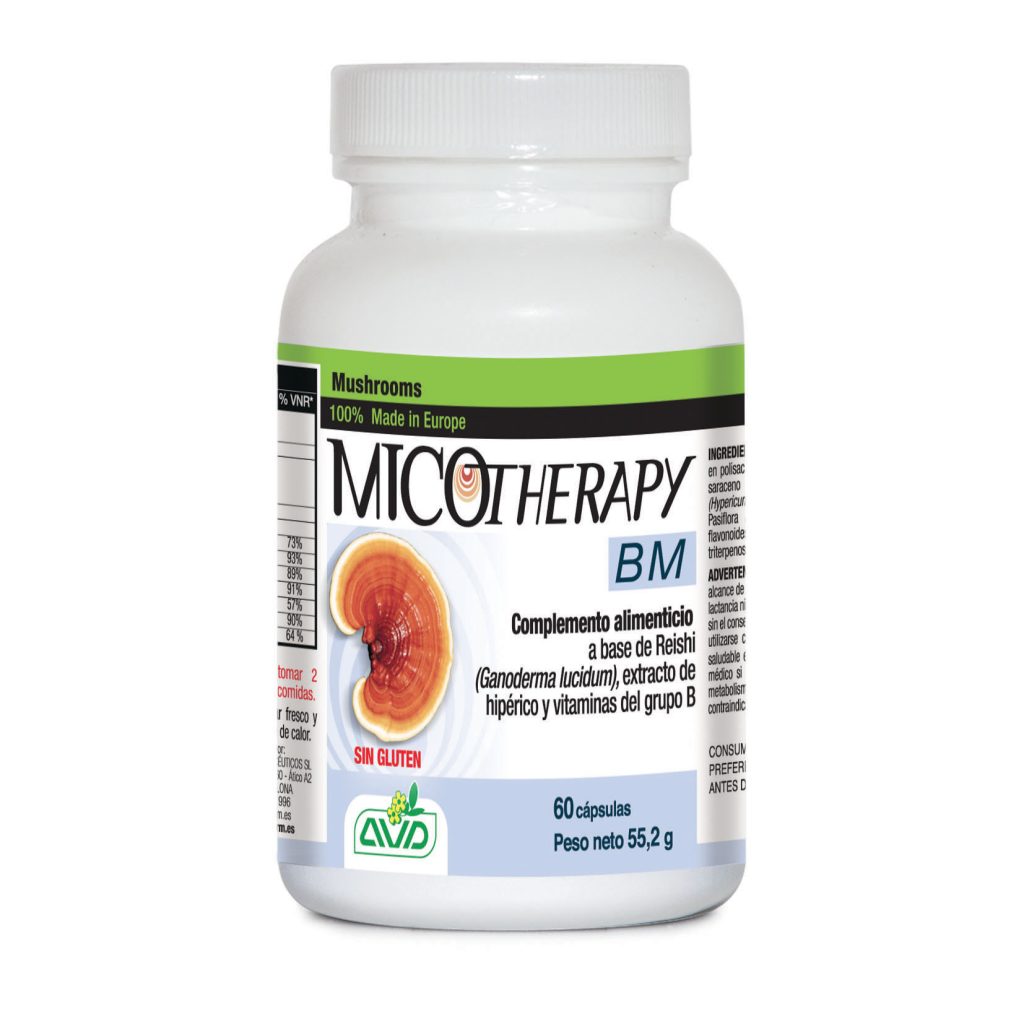
Complemento alimenticio a base de Reishi procedente de agricultura ecológica, extractos vegetales y vitaminas B en forma natural.
Efecto fisiológico:
Basado en el extracto seco de Reishi de la agricultura orgánica, Micotherapy BM realiza una acción calmante natural, reduciendo naturalmente la ansiedad. Gracias a la acción sinérgica de sus componentes, ayuda a mejorar la calidad del sueño y la capacidad de manejar el estrés psicofísico, ayudando a proporcionar una mayor claridad mental.
Propiedades:
- Reishi: también llamado «hongo de eterna juventud» o «hongo de la immortalidad» porque se cree que promueve la longevidad, Reishi se considera tradicionalmente un remedio capaz de restablecer el equilibrio del cuerpo al mejorar la resistencia a las enfermedades. También actúa sobre el sistema nervioso y sobre la liberación de endorfinas endógenas mediante una acción calmante natural, mejora la calidad del sueño y la capacidad de recuperación del organismo
- Extracto seco de Hypericum: también llamado hierba de san Juan, promueve la relajación y el bienestar mental, contribuyendo al estado de ánimo normal, se usa comúnmente en situaciones de depresión leve o moderada, acompañado de ansiedad, cansancio, pérdida de apetito y trastornos del sueño
- Pasiflora: tiene una acción calmante y sedante sobre el sistema nervioso central, con importantes efectos en situaciones de estrés, nerviosismo e insomnio
- Centella: realiza una acción antiinflamatoria y aumenta la oxigenación cerebral al mejorar la claridad mental, la concentración y los ritmos del sueño
- Vitaminas B en forma natural: altamente biodisponibles, son importantes para mantener el equilibrio y proteger el sistema nervioso, tanto desde el punto de vista estructural como funcional
Propiedades:
- Extracto seco de Reishi (Ganoderma lucidum)
- Extracto seco de Hypéricum
- Extracto seco de Passiflora
- Extracto seco de Centella
- Complejo vegetal de vitaminas del grupo B de trigo sarraceno
Dosis recomendada:
2 a 4 cápsulas al día preferiblemente lejos de las comidas
Presentación:
Envase de 60 cápsulas
Conservación y Registro:
Conservar el producto en un lugar fresco y seco resguardado de la luz solar y de fuentes de calor
Código Nacional 196798.5
Libre de Gluten
| CONTENIDO MEDIO DE LOS INGREDIENTES | POR DOSIS DIARIA (2 CAP) | RDA |
| Reishi extracto seco | 660 mg | |
| Aporte de polisacáridos | 165 mg | |
| Trigo sarraceno | 400 mg | |
| Hipéricum extracto seco | 234 mg | |
| Aporte diario de Hipericina | 0,7 mg | |
| Relación hiperforinas/hipericina | no superior a 7 | |
| Passiflora extracto seco | 200 mg | |
| Centella extracto seco | 100 mg | |
| Vitamina B1 (tiamina) | 0,8 mg | 73% |
| Vitamina B2 (riboflavina) | 1,3 mg | 93% |
| Vitamina B3 (niacina) | 14,3 mg | 89% |
| Vitamina B5 (ác. pantoténico) | 5,5 mg | 91% |
| Vitamina B6 (piridoxina) | 0,8 mg | 57% |
| Ácido fólico | 180 mcg | 90% |
| Vitamina B12 (cobalamina) | 1,6 mcg | 64% |
Bibliografía:
- Mizuno, T. (1996). Oriental Medicinal tradition of “Ganoderma lucidum (Reishi)» in China. In T. Mizuno & B.-K. Kim(Eds.), Ganoderma lucidum (pp. 101-106). Seoul, Korea : IlYang Pharm. Co. Ltd
- Kim KC, Kim IG. Ganoderma lucidum extract protects DNA from strand breakage caused by hydroxyl radical and UV irradiation.Int J Mol Med 1999 Sep;4(3):273-7
- Wachtel-Galor S, Szeto YT, Tomlinson B, et al. Ganoderma lucidum (‘Lingzhi’); acute and short-term biomarker response to supplementation. Int J Food Sci Nutr. Feb 2004;55(1):75-83
- T.A. Ajith, N.P. Sudheesh, D. Roshny, G. Abishek and K.K. Janardhanan. Effect of Ganoderma lucidum on the activities of mitochondrial dehydrogenases and complex I and II of electron transport chain in the brain of aged rats Experimental Gerontology Volume 44, Issue 3, March 2009, Pages 219-223
- Tang W, Gao Y, Chen G, et al. A Randomized, Double-Blind and Placebo-Controlled Study of a Ganoderma lucidum Polysaccharide Extract in Neurasthenia. J Med Food. 2005;8:53-58
- CS Lai, MS Yu, WH Yuen, KF So, SY Zee, and RC Chang. Antagonizing beta-amyloid peptide neurotoxicity of the anti-aging fungus Ganoderma lucidum. Brain Res, Jan 2008; 1190: 215-24
- R Zhang, S Xu, Y Cai, M Zhou, X Zuo and P Chan. Ganoderma lucidum Protects Dopaminergic Neuron Degeneration Through Inhibition of Microglial Activation. eCAM Advance Access published July 16, 2009
- ZY Zhou, YP Tang, J Xiang, P Wua, HM Jin, Z Wang, M Mori, and DF Cai. Neuroprotective effects of water-soluble Ganoderma lucidum polysaccharides on cerebral ischemic injury in rats. J Ethnopharmacol, August 19, 2010; 131(1): 154-64
- Zhou Y, Qu ZQ, Zeng YS, Lin YK, Li Y, Chung P, Wong R, Hagg U. Neuroprotective effect of preadministration with Ganoderma lucidum spore on rat hippocampus. Exp Toxicol Pathol, November 1, 2012; 64(7-8): 673-80
- Ajith TA et al. Effect of Ganoderma lucidum on the activities of mitochondrial dehydrogenases and complex I and II of electron transport chain in the brain of aged rats. ExpGerontol 2009; 44(3):219-223
- Ding H, et al. Ganoderma lucidum extract protects dopaminergic neurons through inhibiting the production of inflammatory mediators by activated microglia. Sheng Li Xue Bao. 2010 Dec 25;62(6):547-54
- Zhao HB, et al. Polysaccharide extract isolated from ganoderma lucidum protects rat cerebral cortical neurons from hypoxia/reoxygenation injury. J Pharmacol Sci. 2004 Jun;95(2):294-8
- Zhang R, et al. Ganoderma lucidum protects dopaminergic neuron degeneration through inhibition of microglial activation. Evid Based Complement Alternat Med. 2011;2011:156810
- Chen LW, Horng LY, Wu CL, Sung HC, Wu RT. Activating mitochondrial regulator PGC-1alpha expression by astrocytic NGF is a therapeutic strategy for Huntington’s disease. Neuropharmacology. 2012 May 24
- XY Cui, SY Cui, J Zhang, ZJ Wang, B Yu, ZF Sheng, XQ Zhang, and YH Zhang Extract of Ganoderma lucidum prolongs sleep time in rats. J Ethnopharmacol, February 15, 2012; 139(3): 796-800
- Lee JM et al. Inhibition of lipid peroxidation and oxidative DNA damage by Ganoderma lucidum. Phytotherapy Res; 15: 245-249
- Campanini E. – “ Dizionario di fitoterapia e piante medicinali”– Milano, 2012
- Fassina G. – “Lezioni di farmacologia”- Cedam, Padova, 1995
- Speroni E. et al. Neuropharmacological activity of extracts from Passiflora incarnata. Planta Med. 54, 488-491, 1988
- Bourin A.V. et al. A combination of plant extracts in the treatment of outpatients with adjustement disorders with anxious mood. Controlled study versus placebo. Fundam. Clin. Pharmacol. 11, 127-132, 1997
- Speroni E. et al. Role of chrisin in the sedative effects of Passiflora incarnata L. Phytother. Res. 10, suppl. 1, S 98- S 100, 1996
- Speroni E. et al. Sedative effects of crude extracts of Passiflora incarnata after oral administration. Phytother. Res. 10, suppl. 1, S 92-S 94, 1996
- Dhawan K. et al. Anxiolytic activity of aerial and underground parts of Passiflora incarnata. Fitoterapia 72, 922-926, 2001
- Dhawan K. et al. Anti-anxiety studies on extracts of Passiflora incarnata Linneaus. J. Ethnopharmacol. 78, 165-170, 2001
- Akhondzadek S. et al. Passionflower in the treatment of generalized anxiety: a pilot double blind randomized controlled trial with oxazepam. J. Clin. Pharm. Ther. 26, 363-377, 2001
- Dhawan K. et al. Comparative Anxiolytic Activity Profile of Various Preparations of Passiflora incarnata Linneaus: A Comment on Medicinal Plants’ Standardization. J Altern Complement Med 8(3):283-91, 2002
- A Szegedi, R Kohnen, A Dienel, M Kieser. Acute treatment of moderate to severe depression with hypericum extract WS 5570 (St John’s wort): randomised controlled double blind non-inferiority trial versus paroxetine. BMJ 2005;330:503
- Monograph. Hypericum perforatum. Altern Med Rev. 2004 Sep; 9 (3):318-25
- Linde K, Mulrow CD, Berner M, Egger M. St John’s worth for depression. Cochrane Database Syst Rev. 2005 Apr 18;(2):CD000448
- James, J.T.; Dubery, I.A. Pentacyclic Triterpenoids from the Medicinal Herb, Centella asiatica (L.) Urban. Molecules 2009, 14, 3922-3941
- Blumenthal M et al. The Complete German Commission E Monographs: Therapeutic Guide to Herbal Medicines. Klein S, Rister RS, translators. Austin (TX): American Botanical Council; Boston (MA): Integrative Medicine Communications; 1998
para más información visite el sitio: www.micotherapy.it




